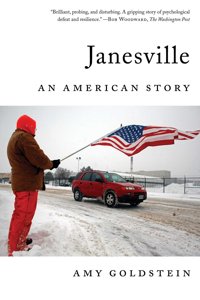‘Janesville’ wins the FT and McKinsey Business Book of 2017

Roula Khalaf, Editor of the FT, selects her favourite stories in this weekly newsletter.
A deeply reported story about the impact of factory closure on a US community is this year’s Financial Times and McKinsey Business Book of the Year.
Janesville by Amy Goldstein was awarded the £30,000 prize at a ceremony in New York on Monday. The book examines the consequences of General Motors’ decision to close an assembly plant in Janesville, Wisconsin, in 2008. It traces the fate of workers and their families, local politicians, unions and companies in the region.
The judges praised the book’s humanity and its relevance for a time when many companies are facing difficult decisions about how to automate and restructure. “It’s a work of enormous integrity, complexity and commitment,” said one, during the judging meeting. “This is a book that every business person should read.”
Lionel Barber, FT editor and chair of judges, said: “Janesville is about the new industrial age and how you deal with it. I think it addresses deeply important policy issues such as skills and retraining. But it’s also a human portrait of people and their community.”
One of Janesville’s insights is that the common policy solution of training dislocated workers in new skills is not always as effective as policymakers would like to think. “Job retraining, it turned out, was not a path to more work or better pay in and around Janesville,” Ms Goldstein writes.
Ms Goldstein, a reporter at the Washington Post, is the first female author to win the award outright; Esther Duflo, shared the award with co-author Abhijit Banerjee for Poor Economics, which won in 2011.

She spent years reporting from Wisconsin, bringing the story up to the eve of Donald Trump’s rise to the US presidency. Janesville is the hometown of Republican politician Paul Ryan, now speaker of the US House of Representatives. In an epilogue, Ms Goldstein points out that Janesville failed “to align with the common wisdom” about how Mr Trump won power, fuelled by the grievances of the white working class. The county that includes Janesville narrowly voted for Hillary Clinton, the Democrat candidate for president last year, despite its economic catastrophe.
In an FT podcast, recorded ahead of the prize, Ms Goldstein explained how she had to win the trust of the local Janesville community.
At the same ceremony, Mehran Gul won the £15,000 Bracken Bower Prize for the best proposal for a business book by an author aged under 35. His proposal — The New Geography of Innovation — examines the rise of innovative start-ups beyond Silicon Valley.
The Business Book of the Year Award was launched in 2005 and goes to the book that provides the “most compelling and enjoyable insight into modern business issues, including management, finance and economics”. The 2016 winner was Sebastian Mallaby for The Man Who Knew, his biography of former Federal Reserve chairman Alan Greenspan.
Authors of the other shortlisted books — whose topics ranged from sexism in Silicon Valley to the history of the iPhone — each receive £10,000. They are: The Spider Network by David Enrich; Adaptive Markets by Andrew Lo; The One Device by Brian Merchant; Reset by Ellen Pao; The Great Leveler by Walter Scheidel.
Barry Diller, chairman and senior executive at IAC and Expedia, was the guest speaker at the New York dinner.
Excerpt from Janesville by Amy Goldstein
Janesville, Wisconsin, lies three fourths of the way from Chicago to Madison along Interstate 90’s path across America from coast to coast. It is a county seat of 63,000, built along a bend in the Rock River. And at a spot on the banks where the river narrows sits the assembly plant.
General Motors started turning out Chevrolets in Janesville on Valentine’s Day of 1923. For eight and a half decades, this factory, like a mighty wizard, ordered the city’s rhythms. The radio station synchronized its news broadcasts to the shift change. Grocery prices went up along with GM raises. People timed their trips across town to the daily movements of freight trains hauling in parts and hauling away finished cars, trucks, and SUVs. By the time the plant closed, the United States was in a crushing financial crisis that left a nation strewn with discarded jobs and deteriorated wages. Still, Janesville’s people believed that their future would be like their past, that they could shape their own destiny. They had reason for this faith.
Long before General Motors arrived, Janesville was an industrious little city, surrounded by the productive farmland of southern Wisconsin. It was named for a settler, Henry Janes, and its manufacturing history began early. A few years before the Civil War, the Rock River Iron Works was making agricultural implements in a complex of buildings along South Franklin Street. By 1870, a local business directory listed fifteen Janesville carriage manufacturers. Along the river, a textile industry thrived—wool, then cotton. By 1880, 250 workers, most of them young women, were weaving cloth in the Janesville Cotton Mills.
As the twentieth century opened, Janesville was a city of about thirteen thousand—descendants of the original settlers from the East Coast and immigrants over the decades from Ireland, Germany, and Norway. Downtown, Franklin and River Streets were lined with factories. Milwaukee and Main Streets were crowded with shops, offices, and, at one point, a saloon for every 250 residents. Stores stayed open on Saturday nights for farm families to come into town once their week’s work was done. The bridge that carried Milwaukee Street over the river was still wooden, but electrified streetcars running north and south from downtown had replaced the old horse-drawn trolley service. Janesville was a railroad hub.
Each day, sixty-four passenger trains, plus freight trains, pulled in and out of town. Raw materials arrived
for factories, politicians for whistle-stop tours, and vaudeville stars for performances at the Myers Grand Opera House.
In Janesville’s long history of making things, two figures stand out. They are homegrown captains of industry, obscure to most Americans but legend to every Janesville schoolkid. They shaped the city’s identity along with its economy.
The first was a young telegraphy instructor in town named George S. Parker. In the 1880s, he patented a better fountain pen and formed the Parker Pen Company. Soon, Parker Pen expanded into international markets. Its pens showed up at world leaders’ treaty signings, at World’s Fairs. Parker Pen imbued the city with an outsized reputation and reach. It put Janesville on the map.
The second was another savvy businessman, Joseph A. Craig, who made General Motors pay attention to Janesville’s talent. Near the close of World War I, he maneuvered to bring GM to town, at first to make tractors. Over the years, the assembly plant grew to 4.8 million square feet, the playing area of ten football fields. It had more than seven thousand workers in its heyday and led to thousands of jobs at nearby companies that supplied parts. If Parker Pen put Janesville on the map, GM kept it there. It proved that Janesville could surmount adversity under trying circumstances, seemingly immune to the blows of history. During the Great Depression, it closed—and reopened a year later. During a sitdown strike, a seminal event in U.S. labor history, while autoworkers rioted elsewhere, peace held in Janesville. During World War II, the plant turned out artillery shells as part of the home front before postwar production resumed, greater than ever. Even as the auto industry’s fortunes in the 1970s started to fade, dooming other plants, Janesville’s assembly line moved on and on.
So when the assembly plant stopped on a frozen December morning of 2008, how could people in town have known that this time would be different? Nothing in their past had prepared them to recognize that another comeback would not save them now.
The work that vanished—as many as nine thousand people lost their jobs in and near this county seat in 2008 and 2009—was among 8.8 million jobs washed away in the United States by what came to be known as the Great Recession. This was, of course, not the first moment at which some American communities have hemorrhaged jobs in their defining industries. The textile mills of Lowell, Massachusetts, began to shut down or move to the South as early as World War I. Youngstown, Ohio’s, Black Monday of 1977 began to erase an eventual fifty thousand jobs in steel and related industries. But this mighty recession—the worst economic time since the 1930s—stole American jobs, not in a single industry, not in a cluster of ill-fated communities, but up and down the economic ladder, from the East Coast to the West, in places that had never been part of the Rust Belt or any other bad economic belt and had never imagined that they would be so bruised. Places like Janesville.
Comments